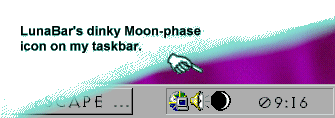

 |
||
 |
||
|
|

The odds are that she is drifting through the sky, maybe beaming through your window as you read this. Exactly what she is doing is something for a more detailed almanac (see later) but here, in case you were wondering, is the current phase of the Moon and a couple of snippets of other information. I blagged this JavaScript from Midge (ehw7@aber.ac.uk) and gave it a makeover. Midge has a Wiccan website which, vexingly, I have lost the link to. Do let me know if you find it.
One of my oddest lunar connections was something I uncovered while working on EDS Healthcare's helpdesk. We were supporting a range of hospital products - inventory and patient tracking software - and I was responsible for putting together statistics on the number of problems reported by our users. Compiling these figures over a period of about eighteen months, I noticed a pronounced periodicity in the figures. There were predictable peaks and troughs in activity. This was exactly what I was looking for, as it meant that we could manage our resources better - but I wanted to know what was causing it. The first thing to do was rule out the known causes of peaks in problem reports. The known causes were:
I could rule out Monday mornings immediately. The period of the peaks and troughs was longer than that, at about a month. New version rollouts could be ignored too. Although they caused big predictable blips, they were only done irregularly. Month-end work seemed to be the best candidate. But month-end work was always done at the end of the calendar month - and the period of my blips was more like 29 days. The peak drifted back through the month over the whole sample. Twenty-nine days? That rang a bell. It's more or less the period of the Moon's phases. I mentioned this to my manager, who laughed. "Phases of the Moon?" she giggled, "Don't be daft. Do you think our users are werewolves?" Well, no-one calls me daft without me giving a serious deconstruction of the reasons. The werewolf suggestion was almost credible - thick furry fingers would make more mistakes when typing, which would result in an increase in reported problems - but I was forced by common sense to discard it. So, with much cracking of knuckles, I set down to understand just what was causing our software to apparently become less reliable - by as much as 30% - during the full Moon. Could it be that the hardware was affected by the tug of our satellite? Tides, plants and women feel it all the time, so why not? The Bristol area has one of the highest tidal swells in the world, too - could that be connected to it somehow? But I had to conclude that this was not the reason, because computer systems are digital, not analogue. An analogue system might be subject to subtle variations in its environment (think about a TV aerial as an example) but digital systems either work or don't. So what else could it be? About this time I had to do some other stats, breaking down those performance figures by product. A couple of our largest systems - patient administration and pathology - were both looked at separately, and they showed little or no periodicity. This was very interesting. It meant that one of our smaller systems was having a disproportionately large effect on our figures. Immediately I hit the stats engine and peeled each system's figures out seperately. And the answer was there, clear as Moonlight. Remember the old saw about how the Police and taxi drivers and such nocturnal workers all dread the full Moon because it's when the loonies come out? You'll hear it referred to on the occasional cop show or in an episode of Casualty and it seems so reasonable that no-one really questions it or thinks about it at all. Well, once again, common sense is proved to be correct. The periodicity was showing itself almost exclusively in our accident and emergency system. This is used to book people into the A&E departments of hospitals. The same hospitals whose nurses dread the full Moon because it's when the nutters and the domestic violence and the street brawls all come streaming in. Our software wasn't Moon-struck - the people were. A little more digging confirmed it. A&E took hugely more patient entries when the Moon was full. There was a heavier load on the network. Printers were busier and thus more likely to jam. With more records being entered or accessed there was a greater chance of errors. And hospital staff, under the heavy workload (and not unaffected themselves) were less efficient in using the system. So there you go: a roundabout way of proving that the Moon really does have a measurable effect on people. And perhaps a reminder that the old wisdom is no less relelvant now.
There are any number of reasons for being interested in what the Moon is doing. Astronomers are keen to know when she is full enough to see and when she is above the horizon. Astrologers are more interested in which signe she is transiting. The magickal and neopagan community are watching her phases and planning their workings and devotions. Gardeners are considering whether or not to plant. Now you can keep track of the Moon's phases and movements without having to leave your swivel-chair, thanks to a rather natty desktop almanac from clySmic Software. LunaBar, which you can download from their website by clicking here, gives you a little picture of the current Moonphase in your icon tray, and a whole slew of information in an almanac that comes up when you click it. 
LunaBar is shareware, so please give it a try. I found that it made me feel immediately more connected with the world outside my monitor - which has to be a good thing.
|
||||||||||||||||
  
|